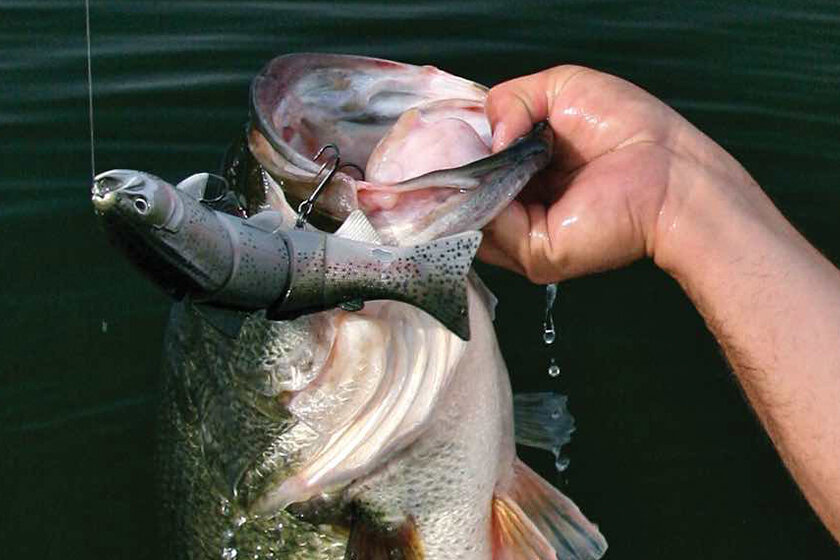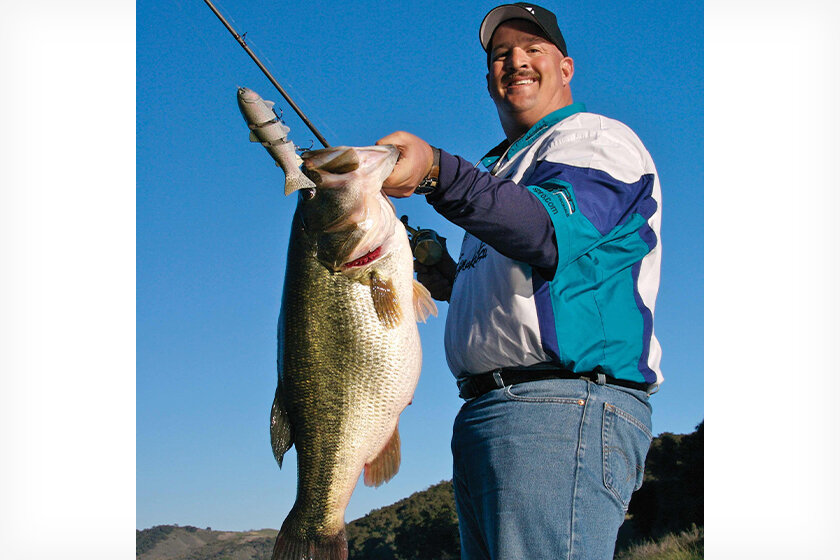California Dreaming: The Land of Giant Double-Digit Bass
By Ken Duke
Most bass anglers know that California has produced some of the heaviest largemouth bass on record for decades. In fact, 20 of the top 25 bass ever caught by anglers anywhere in the world have come from the Golden State.
For a variety of reasons, the chances that a world-record fish is swimming in a California lake now are much lower than they have been in the past, but the state still remains the best bet for anglers in the West to catch a personal-best, double-digit largemouth.
For a bass to reach trophy size, it needs to live a long time, be in a habitat with a long growing season, eat a lot and have the genetic capacity to grow faster and bigger than most bass.
A high percentage of California lakes have that kind of habitat and that kind of bass. Largemouths are not native to California, but they were transplanted there a surprisingly long time ago—in 1879 in Crystal Springs Reservoir in San Mateo County. Their progeny were later distributed throughout the state.
They did well, but these were northern-strain largemouths, which means they were cold-hardy but didn’t grow as large as the bass that have since made California synonymous with world-class fish. Until the late 1960s, the state record was in the low teens. But in the late 1950s, Florida-strain largemouth, which have a higher potential for attaining double-digit weights, began to be transplanted in the state.
Since then, two-dozen California water bodies have produced bass weighing better than 18 pounds, and about half of them are in San Diego County. Most of the extreme top-end fish came from small reservoirs, ranging from just 35 to 1,680 acres, the majority of which have or currently support put-and-take trout fisheries. Because big bass eat small trout, these are the kinds of lakes that anglers looking to catch the largest bass of their lives should focus on fishing.
Even if California doesn’t produce a world record, it’s still the place to go for big fish. We reached out to two experts who have spent years studying the best places to go to catch big bass across the state. The first is famed trophy bass hunter and Los Angeles firefighter Bill Siemantel, who has a 19-13 and two other bass over 18 pounds to his credit. The other is California Inland Fisheries Senior Environmental Scientist John O’Brien, who keeps tabs on population and size trends in the state’s bass waters.
For anglers looking to put a double-digit bass in their boat, these are the fisheries they recommend.
SIEMANTEL’S PICKS
The Delta: In California, “The Delta” means the Sacramento River Delta, which is a low-elevation floodplain about 1,100 square miles in circumference. Much of the bifurcated river system here is low enough to be influenced by the tides. In some parts of the Delta, water levels can change 3 or 4 feet from tide to tide, so when the tide is going out (or coming in) the current should be a factor in your choice of where to cast. Bass will seek slow-water ambush points close to current that washes food by them. The northern end of the Delta tends to have colder water that supports smallmouths; the best bets for largemouths are in the central portion of the Delta near Antioch, Stockton and Tracy.
Lake Amador: Amador is a classic California small-water, big-bass lake with several arms and adjacent points. It’s southeast of Sacramento near Ione and is heavily planted with trout. There is a resort on the lake that rents boats, and many anglers target big bass at night here.
Don Pedro Reservoir: At the other end of the size scale for trophy bass water is Don Pedro’s 13,000 surface acres, formed by a dam across the Tuolumne River in Tuolumne County. It’s the state’s fifth-largest reservoir. The lake features a variety of structure, from shallow to deep water, and hosts shad as an important food source for bass. Camping is available on public land surrounding the lake. Two marinas (Moccasin Point and Fleming Meadows) can offer tips for what’s working best on the day you show up to fish.
New Melones Lake: This reservoir on the Stanislaus River in the central Sierra Nevada foothills spans the border of Calaveras and Tuolumne counties. Well supplied with bass forage, New Melones’ spring bass chase everything from hefty swimbaits to Senko-style baits. The lake also supports smallmouths and some big spotted bass, so go prepared for a mixed bag.
O’BRIEN’S PICKS
Lake Morena: This is a relatively high-elevation lake—3,000 feet up in the foothills of the Laguna Mountains approximately 60 miles east of San Diego—but its shallow, rocky shoreline gives bass plenty of structure and good spawning sites. The lake is heavily stocked with trout and has two campgrounds, although in low-water years, often only the South Campground is open.
Lake Cuyamaca: Also east of San Diego, and even higher in elevation, 110-acre Lake Cuyamaca is San Diego County’s only year-round trout fishery. Lots of trout are planted here, and although the high-elevation cold slows the growth rate of largemouths, there are some 10-plus-pound fish caught in this lake.
Lake Casitas: A reservoir built for drinking water and irrigation in Ventura County, Casitas is one of the most storied big-bass lakes in California. Recreation is allowed, but prospective anglers should visit casitaswater.org/recreation for information on fees, reservations and other regulations.
Castaic Lake: Another of California’s most legendary trophy bass waters is Castaic Lake in Los Angeles County. It should be noted that Castaic is under various regulations, including pre-launch boating inspections for quagga and zebra mussels. To see the regs, visit castaiclake.com. If you’d rather not bring your own boat, there are a number of guides who operate here.
By no means should this be considered an exhaustive list of lakes capable of producing the best largemouth bass of your life. In addition to the lakes above, Siemantel suggests that anglers also look to reservoirs in northern California that stock trout or kokanee salmon on a regular basis.
"The key times for the stockings are from October to April," he says. "If you can find a big largemouth that’s just eaten a couple of trout, it’ll be a giant."
For a list of waters that receive state trout stockings, visit nrm.dfg.ca.gov/FishPlants.
RECORD HOPES IN DECLINE?
Why won’t the next world-record bass come from California? Depends on who you ask.
California remains the top big-bass state in the West, but most experts agree that in the last 20 years their hopes that the state would produce a new world record have dimmed.
For a bass to get to world-record size, almost everything has to be perfect for that fish: It needs the right genetics, the right cover and the right food. If anything isn’t perfect, the bass might still be a monster, it just won’t be a world record.
According to famed trophy hunter Bill Siemantel, one reason that a world-record fish is probably not swimming in a California lake right now is that the trout and kokanee salmon plantings in many fisheries have been sporadic for more than a decade. Instead of regular stockings of 8- to 12-inch rainbows, plantings became much less frequent. It seems the non-native trout were eating native species, and local authorities did not want to threaten those creatures.
Inland Fisheries Senior Environmental Scientist John O’Brien is not optimistic about California’s world-record prospects either. We recently asked him if a world record currently swims in California waters.
"Based on survey and angling records this is not likely," was his response. But rather than point to trout stockings and access as the reason, O’Brien suggests that a shift in angling practices among bass anglers may play a role. Until about 20 years ago, it was common for anglers to catch, keep and eat some of the bass they caught. Now, virtually 100 percent of anglers release every fish. The result is higher bass populations in each lake, and the bass compete with each other. That doesn’t mean that fish can’t get well into the double digits—but they don’t often reach the 20-pound mark.
DIY TROPHY TACTICS
Big fish take big bites.
On a big-bass lake, Bill Siemantel recommends focusing on channels, flats, humps, points and ridges—areas that will hold outsize bass year-round rather than just during the spawn or a particular season. He takes a “top-middle-bottom” approach to finding fish, choosing baits that allow him to cover the various strata. Big bass spend much of their time focused on food, particularly as waters warm in the spring and they gear up for the spawn. Large, rich food sources are what they are after, which is why lakes with trout, shad and crawdads produce big bass.
Siemantel has a reputation for catching giant bass on big swimbaits, particularly the 8-inch BBZ-1 he designed for Spro. He uses that bait and others up to 12 inches, in both floating and sinking models, to fish the water column from top to bottom.
"If you’re looking for fish over 10 pounds, throw a bait much bigger than the norm," he says. "You have to be dedicated and committed to catch a trophy."




